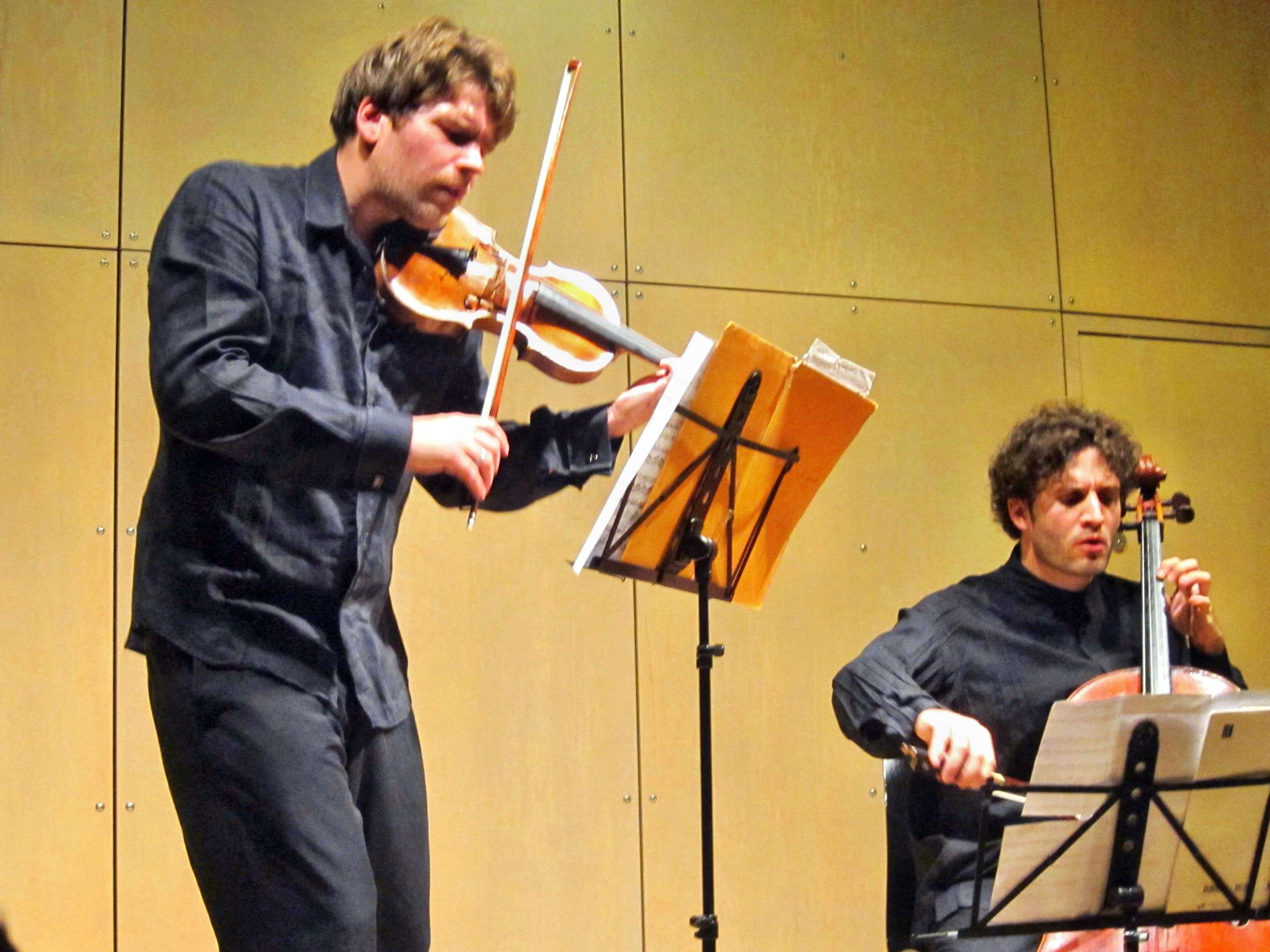|
Back
Bowing in the Rain New York
Austrian Cultural Forum, 11 East 52nd Street
10/15/2012 -
Thomas Larcher: Duo for violin and violoncello (world premiere)
Alfred Schnittke: Stille Musik for violin and violoncello
Maurice Ravel: Sonata in C major for Violin and Cello
Zoltán Kodály: Duo op. 7 for violin and violoncello
Nicolas Dautricourt (Violin), Nicolas Altstaedt (Cello) 
N. Dautricourt, N. Altstaedt (© Coco T. Dawg)
Somehow, two young musicians named Nicolas, managed to accelerate a miserable rain-sodden night into a evening of the sunniest animation.
One might have expected four pieces for solo violin and solo cello in the Austrian Cultural Forum, home to aleatory and abstruse atonality, to garner the usual juiceless respect. But French-German Nicolas Altstaedt and French Nicolas Dautricourt are so experienced in their young age with music of our times, and performing with the best of their generation, that they made the recital into a delicious show.
Their musical artistry is special (see below), but their felicitous attitudes decidedly augmented things. Cellist Altstaedt gave a happily rambling talk about artistic choices, while his body movements during the music were alive, electric, his feet bouncing as much as his bow arm. The gangly violinist, Nicolas Dautricourt seemed to enjoy the proceedings equally well.
Even in a world premiere, the two seemed to play as if Thomas Larcher’s Duo was part of their repertory. As it should be. The Austrian composer is not performed in New York, I believe, but his YouTube representation had showed a composer with prepared pianos and exotic sounds.
This Duo had two movements, the second of which was a frenzied partnership with incessant repetitions of a few notes, all varied by the instruments, which took adventurous runs to the topmost notes and back again, all the time retaining the velocity of the theme cell.
I loved the first movement for its striking changes of mood. Mr. Larcher would go suddenly from the most dissonant chords to modal structures reverting to 14th Century organum, then back again. Granted, several composers–Penderecki and Schnittke, for instance–make a habit of these time trips. Hearing the changes with two stringed instruments makes the change even more distinctive.
Schnittke himself was represented with his violin-cello Stille Nacht, which I find more moody in the original violin/piano arrangement. But Messrs Altstaedt and Dautricourt meandered through those first mysterious measures, then intensifying the work with microtones, chordal runs and all the paraphernalia.
The bookended pieces are relatively popular, and for good reason. The Ravel Duo is a terrific opener, as much for its bluesy-jazzy movement as its mood and obviously difficult canons and love-hate relationships for the two instruments.
But the final longest work, Kodály’s Duo, embodied the mood of the concert. Kodaly wrote many a work for solo cello or cello in ensemble, but this was his most exuberant piece. Its beginning, in fact, was more vivacious then usual, simply because no applause was heard after the Schnittke. Was the audience stunned by Stille Nacht? Were they giving it a reverent silence? Or were they simply unsure that it had ended?.
At any rate Messrs Altstaedt and Dautricourt gave no indication that the Schnittke had ended, and started with those measures that were so undeniably Kodály’s, filled with rhapsody and folk music, flush with colors. Mr. Altstaedt ushered in the Adagio, but when the violin joined him, it was passion and excitement together.
That final movement was deceiving. The first measures were played as recitative, as if the two artists were speaking to each other in tones. That led, though, to a Presto which showed them both having unstoppable fun. To watch, at close range in this intimate auditorium, these two artists tossing notes to one another, challenging each other, and giving all the Magyar magic to this piece was sparkling and (to repeat the original adjective) honestly animated.
Harry Rolnick
|